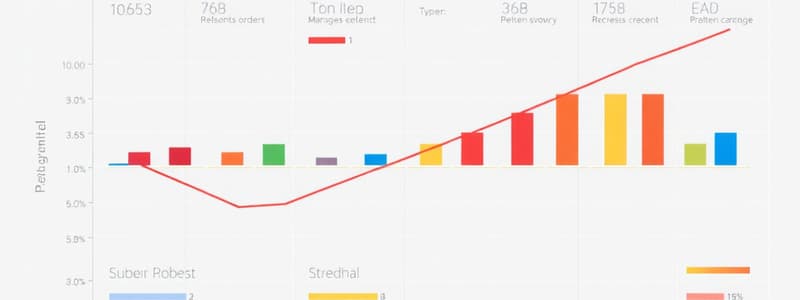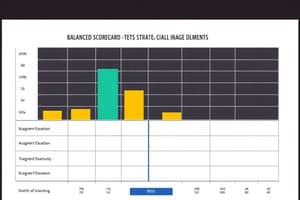Podcast
Questions and Answers
What is one of the main criticisms of relying solely on financial measures for performance management?
What is one of the main criticisms of relying solely on financial measures for performance management?
- They do not address strategic alignment with operational activities. (correct)
- They provide a complete view of historical performance.
- They are considered the most reliable indicators of success.
- They are easy to measure and analyze.
When did the Balanced Scorecard evolve into a framework for enterprise-wide strategic management?
When did the Balanced Scorecard evolve into a framework for enterprise-wide strategic management?
- 2000 (correct)
- 1995
- 1992
- 1996
Which of the following is NOT a critical component of the Balanced Scorecard?
Which of the following is NOT a critical component of the Balanced Scorecard?
- Budgeting (correct)
- Targets
- Initiatives
- Measurements
What function does the Strategy Map serve in the context of the Balanced Scorecard?
What function does the Strategy Map serve in the context of the Balanced Scorecard?
Approximately what percentage of Fortune 1,000 companies currently utilize the Balanced Scorecard?
Approximately what percentage of Fortune 1,000 companies currently utilize the Balanced Scorecard?
Flashcards
Why Financial Measures are Insufficient
Why Financial Measures are Insufficient
Financial measures alone are insufficient for understanding a company's overall performance. The Balanced Scorecard addresses this by providing a comprehensive framework that considers various aspects of performance.
Balanced Scorecard
Balanced Scorecard
A tool that translates strategic goals into actionable objectives and measures.
Strategy Map
Strategy Map
The Balanced Scorecard uses a visual representation called a "Strategy Map" to show the cause-and-effect relationships between different aspects of performance.
Linking Components
Linking Components
Signup and view all the flashcards
Bridging the Gap
Bridging the Gap
Signup and view all the flashcards
Study Notes
Origin of Balanced Scorecards
- Financial measures alone are insufficient to answer crucial strategic questions: "Where are we?", "Where are we going?", and "How will we get there?"
Balanced Scorecard History
- Balanced Scorecard concepts, measures & reporting emerged in 1992.
- Alignment & communication evolved in 1996.
- Enterprise-wide strategic management was emphasized by 2000.
- Harvard Business Review published articles in the 1990s on the Balanced Scorecard.
Widespread Use
- Approximately 70% of Fortune 1,000 companies use the Balanced Scorecard for performance management.
- The tool is also used for strategy development and testing.
- It's widely adopted in the public sector.
Bridging Strategy and Action
- A Balanced Scorecard is a tool to create cause-and-effect linkages within an organization.
- It establishes a line of sight between strategic goals and operational activities to ensure focus on the right things.
- Strategy can be envisioned as a series of cause-and-effect relationships.
Core Principles
- The Balanced Scorecard summarizes strategy on a Strategy Map with four performance perspectives.
- Cause-and-effect links between strategic objectives across the four perspectives are key to the scorecard design.
- Critical elements include measurements, targets, and initiatives.
- A robust structure requires tight connections: goals to objectives, objectives to measurements, and measurements to targets.
Studying That Suits You
Use AI to generate personalized quizzes and flashcards to suit your learning preferences.




